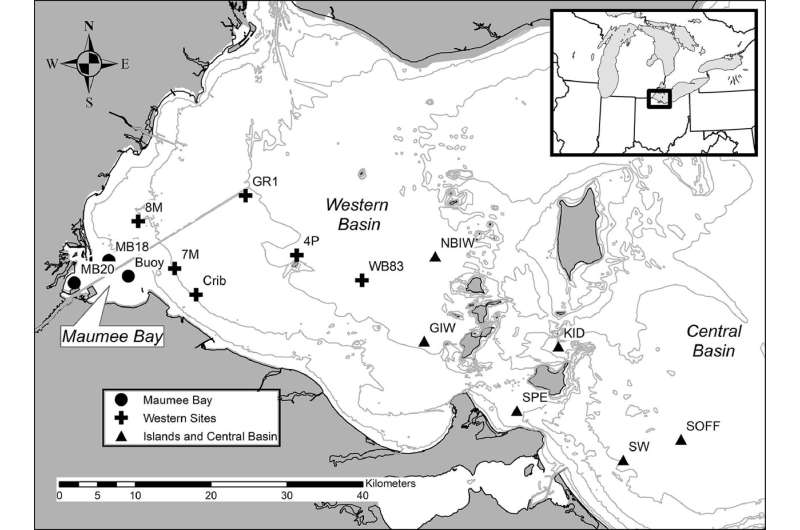This article has been reviewed according to Science X's editorial process and policies. Editors have highlighted the following attributes while ensuring the content's credibility:
fact-checked
trusted source
proofread
Current estimates of Lake Erie algae toxicity may miss the mark

There is more to a harmful algal bloom than the green stuff in water that meets the eye—specifically, a changing hazard level of toxins produced by the microbes that make up the scummy mess.
A new study analyzing toxins produced by Microcystis, the main type of cyanobacteria that compose the annual harmful algal bloom (HAB) in Lake Erie, suggests that the toxicity of the bloom may be overestimated in earlier warm months and underestimated later in the summer.
The research is part of a large project, led by The Ohio State University, designed to develop a more accurate harmful algal bloom toxicity forecast for Lake Erie.
The toxicity relates to the bloom's concentration of the liver toxin microcystin, of which there are hundreds of varieties called congeners defined by very small molecular differences. The analysis showed that the toxicity level of the most common congeners found in Lake Erie relates strongly to nitrogen—when there is more nitrogen present in early warm months, dominant congeners tend to be of the less toxic variety. Later in the season, when nitrogen is nearly gone, the balance of dominant congeners changes to a more toxic type.
"The different levels of toxins will ultimately affect the toxicity and the human health impacts. We know that different populations are more sensitive to the toxins, especially those who have non-alcohol fatty liver disease," said Justin Chaffin, senior researcher and research coordinator at Ohio State's Stone Laboratory and lead author of the study. "Knowing which congeners are around can better inform beach management, better inform water treatment, and better inform those who need to avoid the water when they should avoid it."
The research was published recently in the journal Harmful Algae.
Lake Erie supplies drinking water to an estimated 11 million people in the United States and Canada, and the project led by Chaffin is geared toward developing toxicity forecasts that best prepare water treatment plant operators for the removal of microcystin. A high concentration of the toxin overwhelmed a Lake Erie water treatment plant in 2014, leading to the three-day Toledo drinking water crisis.
But not all microcystin congeners are alike in terms of toxicity. The most abundant and most studied congener in Lake Erie, known as MC-LR, has been shown in recent research to be somewhere in the middle, in terms of toxicity, compared to other congeners in the lake's bloom. In this study, Chaffin and colleagues set out to determine the location and abundance of these different congeners to get a better handle on toxicity trends over the busy summer season.
The team collected samples at 15 sites stretching from Maumee Bay to the Central Basin from June through September in 2018 and 2019, focusing on identifying the concentration of specific microcystin congeners present over time and the changing nutrient levels in the water.
Along with the common MC-LR congener, two other congeners were found to dominate the microcystin populations: MC-RR, whose toxicity is about one-fifth of MC-LR, and MC-LA, estimated to be about 2 1/2 times more toxic than MC-LR.
MC-RR, which is 17.5% nitrogen, was more dominant early in the season, when the water was rich in nitrogen, and MC-LA, which is 10.8% nitrogen, dominated later in the season, when nitrogen levels had substantially dipped—however, the total microcystin concentration was lower at that time as well, meaning overall toxicity may not have dramatically increased.
Detecting congeners doesn't come easily—it requires highly sophisticated equipment and is more expensive than the analysis tool ELISA that's routinely used to measure microcystins in the bloom—which is why current toxicity estimates are probably off, Chaffin said.
"Because ELISA measures overall concentration, basically you're overestimating the toxicity in early summer when the majority of microcystins are a low-toxicity form, and then as summer progresses, the bloom is making more toxic forms, so you may be underestimating the toxicity," he said.
An investment in routinely gathering congener data could improve modeling efforts to predict how the toxicity of the HAB in Lake Erie changes each year.
Chaffin co-authored another recent study that showed using data on toxin concentrations (from existing ELISA measurements that don't take congeners into account), water currents and a bloom's increase in toxin production in a one-week weather map-like simulation improved the accuracy of microcystin forecasting by 79%.
"We took all the data we could find and put it in a hydrodynamic model and ran it under simulations," Chaffin said. "So if you know where the toxins are today and make a map of the bloom like a weather map, you can watch where it's going to go in the next seven days. And if you add biology data to the simulation, you can get a better prediction of where the highest toxin concentrations will be."
"The next step would be to merge the bloom location and toxin concentration forecast with different congeners so we could really forecast the toxicity of the bloom. But lab capabilities would need to be improved to make that possible."
More information: Justin D. Chaffin et al, Microcystin congeners in Lake Erie follow the seasonal pattern of nitrogen availability, Harmful Algae (2023). DOI: 10.1016/j.hal.2023.102466
Provided by The Ohio State University
















